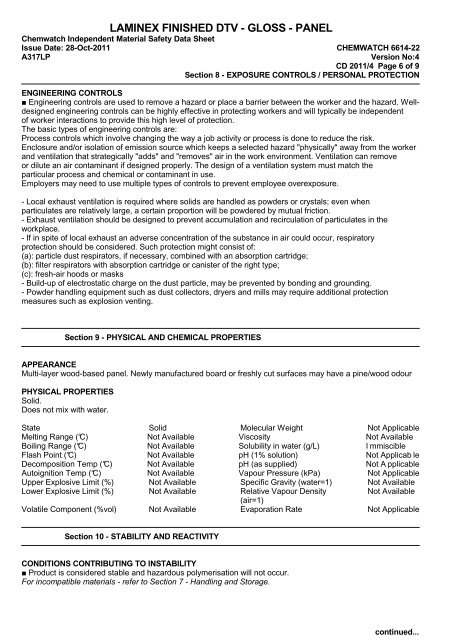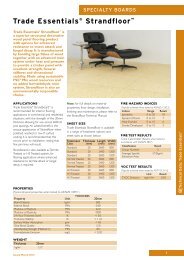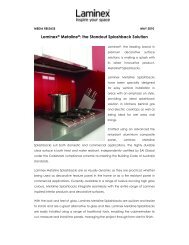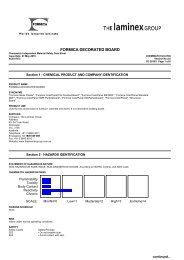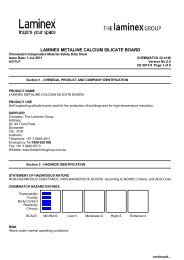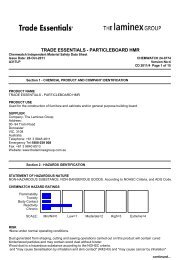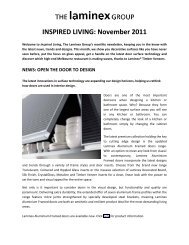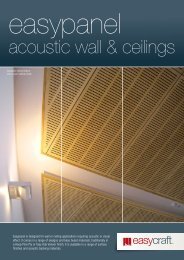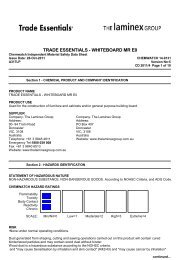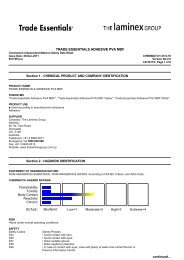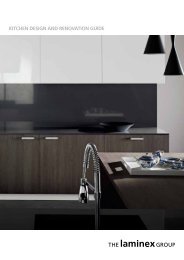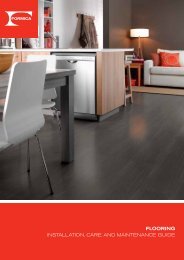Laminex Finished DTV - Gloss - Panel MSDS 6614-22
Laminex Finished DTV - Gloss - Panel MSDS 6614-22
Laminex Finished DTV - Gloss - Panel MSDS 6614-22
You also want an ePaper? Increase the reach of your titles
YUMPU automatically turns print PDFs into web optimized ePapers that Google loves.
LAMINEX FINISHED <strong>DTV</strong> - GLOSS - PANELChemwatch Independent Material Safety Data SheetIssue Date: 28-Oct-2011 CHEMWATCH <strong>6614</strong>-<strong>22</strong>A317LPVersion No:4CD 2011/4 Page 6 of 9Section 8 - EXPOSURE CONTROLS / PERSONAL PROTECTIONENGINEERING CONTROLS■ Engineering controls are used to remove a hazard or place a barrier between the worker and the hazard. Welldesignedengineering controls can be highly effective in protecting workers and will typically be independentof worker interactions to provide this high level of protection.The basic types of engineering controls are:Process controls which involve changing the way a job activity or process is done to reduce the risk.Enclosure and/or isolation of emission source which keeps a selected hazard "physically" away from the workerand ventilation that strategically "adds" and "removes" air in the work environment. Ventilation can removeor dilute an air contaminant if designed properly. The design of a ventilation system must match theparticular process and chemical or contaminant in use.Employers may need to use multiple types of controls to prevent employee overexposure.- Local exhaust ventilation is required where solids are handled as powders or crystals; even whenparticulates are relatively large, a certain proportion will be powdered by mutual friction.- Exhaust ventilation should be designed to prevent accumulation and recirculation of particulates in theworkplace.- If in spite of local exhaust an adverse concentration of the substance in air could occur, respiratoryprotection should be considered. Such protection might consist of:(a): particle dust respirators, if necessary, combined with an absorption cartridge;(b): filter respirators with absorption cartridge or canister of the right type;(c): fresh-air hoods or masks- Build-up of electrostatic charge on the dust particle, may be prevented by bonding and grounding.- Powder handling equipment such as dust collectors, dryers and mills may require additional protectionmeasures such as explosion venting.Section 9 - PHYSICAL AND CHEMICAL PROPERTIESAPPEARANCEMulti-layer wood-based panel. Newly manufactured board or freshly cut surfaces may have a pine/wood odourPHYSICAL PROPERTIESSolid.Does not mix with water.State Solid Molecular Weight Not ApplicableMelting Range (°C) Not Available Viscosity Not AvailableBoiling Range (°C) Not Available Solubility in water (g/L) I mmiscibleFlash Point (°C) Not Available pH (1% solution) Not Applicab leDecomposition Temp (°C) Not Available pH (as supplied) Not A pplicableAutoignition Temp (°C) Not Available Vapour Pressure (kPa) Not ApplicableUpper Explosive Limit (%) Not Available Specific Gravity (water=1) Not AvailableLower Explosive Limit (%) Not Available Relative Vapour Density Not Available(air=1)Volatile Component (%vol) Not Available Evaporation Rate Not ApplicableSection 10 - STABILITY AND REACTIVITYCONDITIONS CONTRIBUTING TO INSTABILITY■ Product is considered stable and hazardous polymerisation will not occur.For incompatible materials - refer to Section 7 - Handling and Storage.continued...


